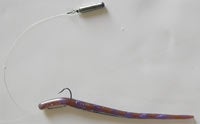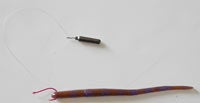Drop Shot Fishing
Whatever you call this technique; dropshot, down shot, or under shot, it's effectiveness has been proven countless times by thousands of anglers all over the world. Generally it is considered a finesse technique involving fairly light weights and small plastic baits. When dropshotting first came to the United States most anglers used it as a deep water technique; fishing directly under the boat for lethargic or suspended fish, especially out west where tournament anglers won a lot of money catching tough winter bass in depths of up to 100 feet! Since then more and more people have used the dropshot the same way they would use any other finesse worm technique like split shotting or darter heading; cast it up on the bank and shake it back to the boat, working through structure and along ambush points. The hooks and weights used for dropshotting have become more sophisticated in the last few years and every major rod manufacturer has designed tapers specifically for the technique.

If you can fish a plastic worm, you can dropshot. Buy a pack of dropshot hooks from your favorite manufacturer and some dropshot weights and you're in business, you just have to know the Palomar Knot to rig it correctly. (See attached diagram) Or, you can buy dropshot rigs pre-tied from Gamakatsu, just tie a small barrel swivel to you line and tie on the Gamakatsu rig. Our best selling hooks are size #1 and #2, but sizes range from 2/0 down to #6. Weights range from 1/8 up to 1/2 ounce, but the best selling weights are 3/16 and 1/4 ounce. Line is also a special consideration. This is a light line technique and 4-10 pound test is usually the range with most anglers using 6-8 pound. Fluorocarbon line has also gained in popularity with dropshot anglers and some people use fluorocarbon up to 12 pound test. Most anglers throw the rig on a light spinning rod but baitcasting outfits are being used more frequently, especially in Southern California where dropshotting is a part of just about every bass fisherman's game plan. If line twist becomes a factor after a long day of dropshotting, try tying a small barrel swivel 18 inches or so above the hook.

The baits used for dropshotting are as varied as our imagination can make them, but most anglers choose a 3-5 inch straight tail or curl tail worm or one of the new dropshot minnows. Zoom makes a Tiny Brush Hog for dropshotting and many people opt for one of the Slim Senkos, but the key is to make sure there is plenty of action when you shake it. Generally the bait is 'nose hooked;' the tip of the worm is impaled on the hook and pushed down onto the bend which leaves an open hook, so often the bass hooks itself when they bite. Sometimes wacky rigging is effective, especially with the Senkos. If you're fishing in an area where there is wood on the bottom, try a #1, #2, or #4 wide gap hook and 'Texas-rig' the worm to avoid sticking the hook into the brush. When you are not using an open hook you should opt for slightly heavier line since you have to set the hook with some authority to push the point through the worm and into the fish's jaw.

The length of the 'leader,' or the line that extends below the hook that the weight is attached to, is also important. When fishing rock or mud banks, anywhere from 6 to 18 inches of leader is appropriate, depending on what the fish are doing; suspending or relating to the bottom, eating shad or crawdads. If you are fishing in a lake with lots of grass and weeds or other bottom clutter, make the leader long enough so the worm is above the weeds so the bass can see it. Chances are most bass have not seen a juicy-looking Green Weenie dancing along above the weeds and it will be irresistible!
Now that you are rigged up and have chosen the perfect worm, it's time to go fishing! Cast the rig anywhere you want to fish some bass-holding structure and let the weight make contact with the bottom. If you fish light worms or jigs, you know the 'feel' of the bottom. If you are not so familiar with those techniques, drop your rod tip from time to time and make sure there is slack in your line, which indicates the weight is resting on the bottom. If the line stays straight it means the weight is still dropping and you should let out enough line to reach bottom. Gently shake the worm and make it dance a few inches off the bottom while the weight stays on the bottom, and you'll get bit.
Dropshotting is also very effective on deep, suspended fish. If you've located a school of bass suspended on deep structure, position the boat over or near them and drop the bait right on top of them. Shake the worm keeping the weight on the bottom with some long pauses and work the area carefully, especially in the cold months and your patience may be rewarded with a livewell full of quality bass no one else can catch. This is the time that a long leader may be in order, try to make it long enough to put the worm at the level the fish are holding; 3, 4, 5 feet or more is sometimes necessary.
Often the take is virtually undetectable and you may just notice a little more weight on the line. In that case set the hook. In this game, swings don't count against you. Many experienced dropshotters will occasionally lift the rig a few feet just to see if there's a fish on the hook that they didn't feel. Work the bait through the area you think the fish are holding, crank up and repeat. One of the benefits of using the dropshot weights is that if they get hung up and you can't shake them loose, when you pull hard the clip will cut the line and all you need to do is clip on another weight and you're instantly back in the water.
Many anglers prefer the 'reel set' to set the hook rather than the traditional 'rip lips' hookset. The sharp, light wire dropshot hooks will penetrate easily with light pressure and you risk breaking the light line on a heavy fish with a hookset that is too hard. A 'reel set' just means you reel in line as you lift the rod, all in one motion creating a steadily increasing pressure on the point of the hook instead of quick, sharp, line snapping jerks. Now is the time you hope you've invested in good equipment and that it is well maintained. A heavy bass will put up a pretty good fight on the light rig and you'll want the hook to be sharp and rust free and the drag on your reel to pull smoothly and not start up with a jerk. You'll also want your rod to be strong enough to move the fish away from line busting cover, but soft enough to protect the light line from a sudden run, especially at the boat. If all these components are perfect and you can keep your adrenaline under control, you'll be amazed at the quality of fish you can catch on this exciting light line technique.
There are variations on this technique all over the country. One interesting technique is using the dropshot rig in flipping situations when the bass are not relating to the b bottom but suspended in brush or grass. Of course, this variation requires heavier line and bigger hooks, but a bug fat Brush Hog or Sweet Beaver swimming merrily along 2 or 3 feet off the bottom and not just quickly falling past a bass' nose, can sometimes really be a way to get some quality bites.